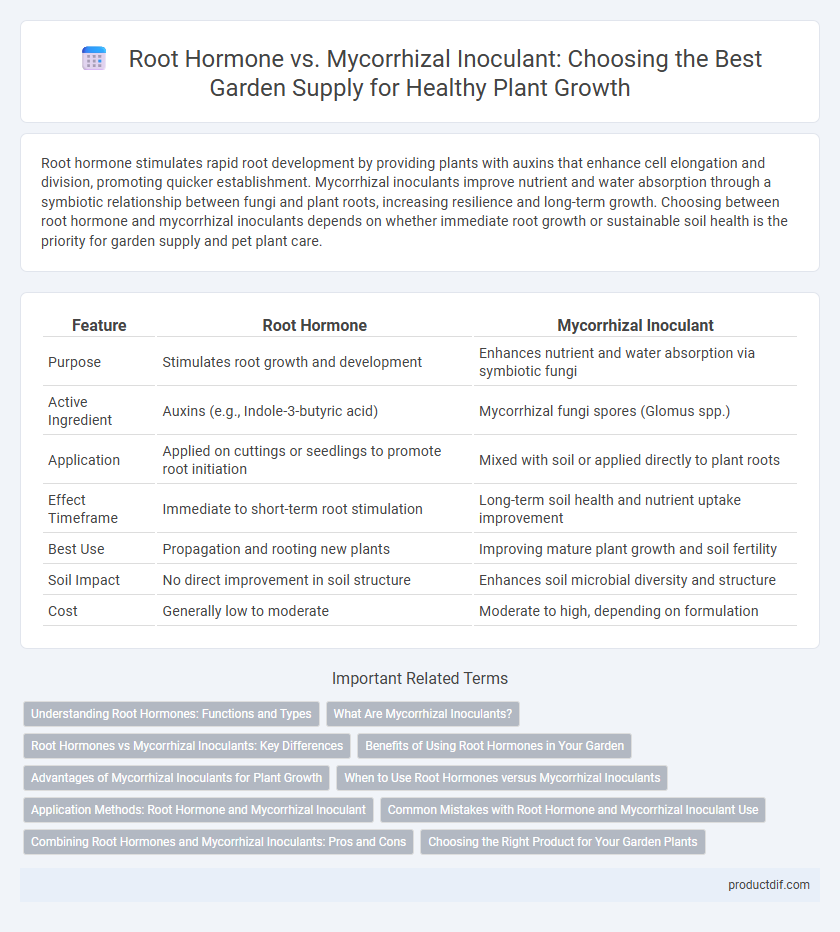Root hormone stimulates rapid root development by providing plants with auxins that enhance cell elongation and division, promoting quicker establishment. Mycorrhizal inoculants improve nutrient and water absorption through a symbiotic relationship between fungi and plant roots, increasing resilience and long-term growth. Choosing between root hormone and mycorrhizal inoculants depends on whether immediate root growth or sustainable soil health is the priority for garden supply and pet plant care.
Table of Comparison
| Feature | Root Hormone | Mycorrhizal Inoculant |
|---|---|---|
| Purpose | Stimulates root growth and development | Enhances nutrient and water absorption via symbiotic fungi |
| Active Ingredient | Auxins (e.g., Indole-3-butyric acid) | Mycorrhizal fungi spores (Glomus spp.) |
| Application | Applied on cuttings or seedlings to promote root initiation | Mixed with soil or applied directly to plant roots |
| Effect Timeframe | Immediate to short-term root stimulation | Long-term soil health and nutrient uptake improvement |
| Best Use | Propagation and rooting new plants | Improving mature plant growth and soil fertility |
| Soil Impact | No direct improvement in soil structure | Enhances soil microbial diversity and structure |
| Cost | Generally low to moderate | Moderate to high, depending on formulation |
Understanding Root Hormones: Functions and Types
Root hormones, primarily auxins, cytokinins, and gibberellins, regulate root growth, cell division, and elongation, enhancing plant development and stress resistance. Auxins stimulate root initiation and promote lateral root formation, while cytokinins influence cell differentiation and nutrient allocation. Understanding these hormone functions helps optimize garden supply applications for improved root establishment and overall plant health.
What Are Mycorrhizal Inoculants?
Mycorrhizal inoculants contain beneficial fungi that form symbiotic relationships with plant roots, enhancing nutrient and water absorption by extending the root system. These fungi improve soil health and plant resilience by increasing the availability of phosphorus and essential micronutrients. Unlike root hormones that stimulate root growth chemically, mycorrhizal inoculants naturally boost plant growth and overall garden productivity through biological interactions.
Root Hormones vs Mycorrhizal Inoculants: Key Differences
Root hormones stimulate cell division and elongation in plant roots, accelerating rooting and enhancing early plant establishment. Mycorrhizal inoculants introduce symbiotic fungi that improve nutrient and water absorption by extending the root system's reach. While root hormones act directly on root growth, mycorrhizal inoculants foster beneficial microbial relationships for long-term soil health and plant resilience.
Benefits of Using Root Hormones in Your Garden
Root hormones stimulate rapid root development by promoting cell division and elongation, enhancing the success rate of cuttings and transplants. They improve nutrient and water uptake efficiency, leading to healthier, more vigorous plants with increased resistance to environmental stress. Using root hormones accelerates establishment time, allowing plants to grow stronger and produce higher yields in your garden.
Advantages of Mycorrhizal Inoculants for Plant Growth
Mycorrhizal inoculants enhance plant growth by improving nutrient and water absorption through symbiotic relationships with plant roots, leading to increased drought resistance and overall plant health. These beneficial fungi expand the root surface area, facilitating better access to phosphorus and other essential minerals unavailable through root hormones alone. Unlike root hormones, mycorrhizal inoculants also boost soil microbial diversity, promoting sustainable soil fertility and long-term plant vitality in garden environments.
When to Use Root Hormones versus Mycorrhizal Inoculants
Root hormones are most effective when propagating cuttings or transplanting seedlings, as they stimulate root development through synthetic auxins like indole-3-butyric acid (IBA). Mycorrhizal inoculants are best applied in nutrient-poor soils or during the early planting stages to enhance symbiotic relationships between fungi and plant roots, improving nutrient uptake and soil health. Using root hormones accelerates root emergence, while mycorrhizal inoculants support long-term plant growth and resilience in challenging soil conditions.
Application Methods: Root Hormone and Mycorrhizal Inoculant
Root hormone is typically applied by dipping plant cuttings directly into a powder or liquid concentrate before planting to stimulate root development. Mycorrhizal inoculants are introduced by mixing the fungal spores into the soil or root zone, ensuring symbiotic fungal networks enhance nutrient uptake. Precise application methods optimize plant health by promoting root establishment with hormones and improving soil nutrient absorption through mycorrhizal fungi.
Common Mistakes with Root Hormone and Mycorrhizal Inoculant Use
Common mistakes with root hormone include overapplication, which can damage delicate plant tissue and inhibit root growth, and neglecting to follow specific dosage instructions for different plant species. Users often confuse root hormone with mycorrhizal inoculants, applying one when the other is more appropriate, leading to suboptimal plant development and soil health. Improper storage and use of mycorrhizal inoculants, such as exposure to sunlight or excessive heat, can reduce fungal viability and diminish their symbiotic benefits for nutrient absorption.
Combining Root Hormones and Mycorrhizal Inoculants: Pros and Cons
Combining root hormones and mycorrhizal inoculants enhances plant growth by stimulating root development and improving nutrient absorption through symbiotic fungi. Root hormones like auxins promote root cell elongation, while mycorrhizal fungi increase phosphorus uptake and soil structure. However, excessive hormone use can inhibit fungal colonization, reducing the effectiveness of mycorrhizal inoculants, so balanced application rates are crucial for optimal results.
Choosing the Right Product for Your Garden Plants
Root hormone stimulates root growth by providing synthetic or natural auxins, ideal for propagating cuttings and accelerating plant establishment. Mycorrhizal inoculants enhance nutrient and water absorption by fostering symbiotic relationships between fungi and plant roots, benefiting overall plant health and stress resistance. Selecting between root hormone and mycorrhizal inoculant depends on your garden plants' needs: use root hormone for rooting cuttings and transplant success, while mycorrhizal inoculants are best for improving soil biology and long-term plant vigor.
Root hormone vs Mycorrhizal inoculant Infographic

 productdif.com
productdif.com